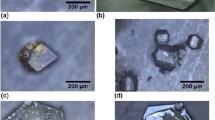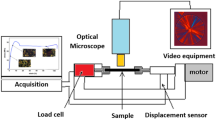Abstract
Purpose. To identify the slip system of L-lysine monohydrochloride dihydrate (LH) and to relate it to the deformation behavior under uniaxial compression.
Methods. The indentation hardness of the {100} face and the indentation moduli of the {100} and {011} faces of plate-shaped single crystals of LH (LHP) were determined using Knoop and Berkovich indenters, respectively. The deformation behavior during uniaxial compression was studied by the punch-stress vs. punch-displacement profile and by electron microscopy of the deformed crystals within cracked compacts.
Results. The different indentation (elastic) moduli of the {100} and {011} faces of the crystals are consistent with the molecular packing density along these planes and suggest anisotropy. The existence of the {001} <100> slip system is proposed based on the pattern of changing indentation hardness with varying orientation of the Knoop indenter. A jagged uniaxial compression profile suggests deformation by mechanical twinning and not simple slip. The hypothesis of deformation by mechanical twinning is supported by the appearance of twin bands along the crystal faces as observed by electron microscopy of the cracked compacts.
Conclusions. During compression, most LHP crystals have their {100} faces oriented normal to, or inclined to, the compression axis, thereby facilitating plastic deformation along the {001} <100> slip system by mechanical twinning. Due to the low attachment energy between them, the {001} planes can also act as cleavage planes. This study demonstrates that knowledge of the crystal structure and slip systems can be used to model the tableting and compaction behavior of molecular crystals, such as LH.
Similar content being viewed by others
REFERENCES
J. M. Newton, A. B. Mashadi, and F. Podczeck. The mechanical properties of a homologous series of benzoic acid esters. Eur. J. Pharm. Biopharm. 39:153–157 (1993).
S. Pedersen and H. G. Kristensen. Compaction behavior of 4-hydroxybenzoic acid and two esters compared to their mechanical properties. Eur. J. Pharm. Biopharm. 41:323–328 (1995).
W. Duncan-Hewitt and G. C. Weatherly. Modeling the uniaxial compaction of pharmaceutical powders using the mechanical properties of single crystals. I. Ductile materials. J. Pharm. Sci. 79:147–152 (1990).
W. Duncan-Hewitt and G. C. Weatherly. Modeling the uniaxial compaction of pharmaceutical powders using the mechanical properties of single crystals. II. Brittle materials. J. Pharm. Sci. 79:273–278 (1990).
W. C. Duncan-Hewitt. Predicting the relative rate of wear of pharmaceutical compacts using the mechanical properties of their constituent crystals. Powder Technol. 60:265–272 (1990).
W. Duncan-Hewitt. Uniaxial compaction modeled using the properties of single crystals. Drug Dev. Ind. Pharm. 19:2197–2240 (1993).
R. J. Roberts, R. C. Rowe, and P. York. The relationship between Young's modulus of elasticity of organic solids and their molecular structure. Powder Technol. 65:139–146 (1991).
R. J. Roberts, R. C. Rowe, and P. York. The relationship between the fracture properties, tensile strength and critical stress intensity factor of organic solids and their molecular structure. Int. J. Pharm. 125:157–162 (1995).
R. J. Roberts, R. C. Rowe, and P. York. The relationship between indentation hardness of organic solids and their molecular structure. J. Mater. Sci. 29:2289–2296 (1994).
R. J. Roberts and R. C. Rowe. The solubility parameter and fractional polarity of microcrystalline cellulose as determined by mechanical measurement. Int. J. Pharm. 52:213–219 (1989).
A. D. Mighell, V. L. Himes, and J. R. Rodgers. Space-group frequencies for organic compounds. Acta Crystallogr. A39:737–740 (1983).
W. C. Duncan-Hewitt, D. L. Mount, and A. Yu. Hardness anisotropy of acetaminophen crystals. Pharm. Res. 11:616–623 (1994).
M. T. Sprackling. The Plastic Deformation of Simple Ionic Crystals, Academic Press, New York, 1976, pp. 17–19.
N. Kravchenko, R. V. Vizgert, and V. P. Kravchenko. Phase equilibria and crystallization kinetics in the system L-lysine hydrochloride-water. Ukrainskii Khimicheskii Zhurnal 53:799–803 (1987).
T. W. Wu. Microscratch and load relaxation tests for ultra-thin films. J. Mater. Res. 6:407–426 (1990).
M. F. Doerner and W. D. Nix. A method for interpreting the data from depth-sensing indentation instruments. J. Mater. Res. 1:601–609 (1986).
Z. Berkovitch-Yellin. Toward an ab initio derivation of crystal morphology. J. Am. Chem. Soc. 107:8239–8253 (1985).
R. Docherty, G. Clydesdale, K. J. Roberts, and P. Bennema. Application of Bravais-Friedel-Donnay-Harker attachment energy and Ising models to predicting and understanding the morphology of molecular crystals. J. Phys. D: Appl. Phys. 24:89–99 (1991).
S. L. Mayo, B. D. Olafson, and W. A. Goddard. Dreiding: A generic force field. J. Phys. Chem 94:8897–8909 (1990).
D. A. Wright and R. E. Marsh. The crystal structure of L-lysine monohydrochloride dihydrate. Acta Crystallogr 15:54–64 (1962).
D. Tabor. Gases, Liquids and Solids and Other States of Matter, 3rd edition, Cambridge University Press, Cambridge, United Kingdom, 1991, pp. 153–174.
F. W. Daniels and C. G. Dunn. The effect of orientation on Knoop hardness of single crystals of zinc and silicon ferrite. Trans. Am. Soc. Metals 41:419–442 (1949).
M. V. Klassen-Neklyudova. Mechanical Twinning of Crystals, Consultants Bureau, New York, 1964, pp. 6, 101-105.
Author information
Authors and Affiliations
Corresponding author
Rights and permissions
About this article
Cite this article
Bandyopadhyay, R., Grant, D.J.W. Plasticity and Slip System of Plate-Shaped Crystals of L-Lysine Monohydrochloride Dihydrate. Pharm Res 19, 491–496 (2002). https://doi.org/10.1023/A:1015151830473
Issue Date:
DOI: https://doi.org/10.1023/A:1015151830473




